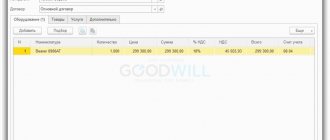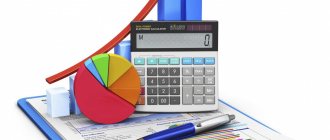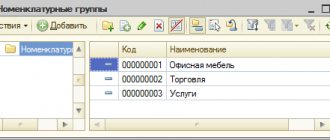Account 20 is closed depending on the chosen cost distribution method:
- the balance can only be due to work in progress;
- the direct method writes off 43, 90 accounts;
- the indirect method runs through intermediary accounts 40, 43;
- the direct implementation method debits to account 90;
- in 1C versions 8.2 and 8.3 the account is closed automatically.
In accounting, closing a month is a whole cycle of operations that must be carried out to correctly form the company’s balance sheet.
Work in progress: reflected in reporting
The cost of production costs not written off to the cost of finished products (work performed, services) is recognized as the cost of work in progress.
Work in progress is reflected in the balance sheet asset in the 2nd section “Current assets” in the line “Inventories”, being part of the amount of all inventories available at the reporting date. Read more about the structure of the balance sheet in the article “Balance sheet (assets and liabilities, sections, types)” .
You will find information on the procedure for filling out a balance sheet in this material .
You will learn how to fill out a balance sheet for “simplified” people by reading the material “How to fill out a balance sheet under the simplified tax system?” .
Work in progress: accounting account
Costs in work in progress are taken into account in production cost accounts: 20 “Main production”, 23 “Auxiliary production”, 29 “Service production and facilities”. But the answer to the question whether the costs of work in progress in accounting will be formed taking into account the costs accumulated in accounts 25 “General production expenses” and account 26 “General expenses” depends on what the organization has written down in its accounting policy.
Costs collected on account 25 for the month can be fully attributed to the main production cost account (20), or can be distributed either to 2 accounts (20 and 23) or to all 3 direct cost accounts (20, 23, 29) . The expenses accumulated on account 25, together with direct costs, form the production cost of products, works or services.
Account 26 can be distributed similarly to account 25 (then the full cost will be collected on the corresponding accounts), or you can write off the entire amount collected on it every month to the financial result (to the debit of account 90). In the latter case, the cost of a specific product (work, service) will not include its data.
Read more about account 20 in the material “Account 20 in accounting nuances).”
Accounting for losses
Products that do not meet quality standards or contracts are considered defective. If it is possible to bring the product to the required parameters, then such a defect is considered correctable. DT28 displays the cost of written-off products. According to KT28 - amounts to be withheld from the culprits, suppliers, valuation of the costs of restoring the product.
Let's look at typical transactions (for convenience, we will again present them in the form of a table).
| Operation | DT | CT |
| Materials were released to correct defective products | 28 | 10 |
| Salaries accrued to employees who corrected products | 70 | |
| Insurance premiums accrued | 69 | |
| The cost of rejected products has been written off | 20 | |
| The cost of the marriage was withheld from the salary of the guilty person | 70 | |
| Received defective parts | 10 | 28 |
| Claims filed with suppliers | 76-2 |
The cost of defective products is written off from DT28 to accounting account 20. Closing the account means that all losses from the barque are compensated. Analytics is carried out by departments, expense items, types of products, culprits and causes of defects.
Composition of main production costs
Account 20 is used to account for direct and indirect expenses incurred in connection with:
- with the production of products of any kind;
- provision of all types of services;
- performing construction and contracting, design, survey and geological exploration work;
- carrying out repair work;
- carrying out design and research work, etc.
Direct expenses are written off to the debit of the “Main production” account from the credit of the accounts:
- 02 and 05 - regarding depreciation of property used for main production
- 10, 15, 16, 21 - for used inventories and costs associated with their acquisition;
- 60 and 76 - for production services directly related to the main production;
- 69 and 70 - regarding the salaries of the main production personnel and charges for it.
Defects subject to correction are also written off for the main production (Dt 20 Kt 28). Every month, from the credit of account 23 to account 20, part of the costs of auxiliary production is received, from the credit of account 25 - indirect costs (or part thereof) to ensure production, from the credit of account 26 - part of general business expenses (if the organization does not use the direct costing method and does not write off these expenses are debited to account 90).
Examples of production cost accounting entries
Example No. 1 of posting cost accounting in production
The organization provides services, revenue for services is 36,000 rubles. including VAT 6000 rub. Expenses associated with the provision of services: salary 8,000 rubles, material expenses 2,000 rubles. What entries are reflected in the accounting department?
| Sum | Debit | Credit | Operation name |
| 8000 | 20 | 70 | Salary expenses included |
| 2000 | 20 | 10 | Material costs taken into account |
| 10000 | 90/2 | 20 | The cost of services for sale has been written off |
| 36000 | 62 | 90/1 | Services provided |
| 6000 | 90/3 | 68 | VAT charged on services provided |
| 20000 | 90/9 | 99 | The financial result is reflected (in this example, profit) |
Formation of the balance of work in progress
The actual cost of manufactured products (works, services) is written off from the credit of the “Main production” account. In this case, account 20, depending on the adopted accounting policy, corresponds with accounts 40, 43, 90.
The balance of account 20 remaining at the end of the month reflects the value of the main work in progress (WIP).
Balances on accounts 23 “Auxiliary production” and 29 “Service farms” are formed in a similar way. Accordingly, the balance on account 23 shows the cost of auxiliary work in progress, and the balance on account 29 shows the cost of work in progress at service farms.
The balance of work in progress in accounts 20, 23, 29 is the balance of work in progress in accounting for the organization as a whole. Work in progress - account 20 + account 23 + account 29, not closed at the end of the reporting period - the balances on them are summed up with other data entered in the “Inventories” line in the balance sheet.
The procedure for filling out a balance with a breakdown of accounts is discussed in detail in the Guide from ConsultantPlus. Get free trial access to the system and study the material.
Does not apply to work in progress:
- raw materials, supplies, purchased finished products transferred to workshops (sites), but not processed;
- rejected semi-finished products that cannot be corrected.
Read about the entries that arise when accounting for irreparable defects in the article “Accounting for defects in production - accounting entries.”
Closing 20 accounts
Important! The method of closing account 20 should be specified in the accounting policy, and it should also indicate the distribution base, if necessary.
There are 3 options for closing an account:
- Direct method;;
- Intermediate method
- Direct sales of manufactured products.
Important! Before closing account 20, it is necessary to allocate the balances of work in progress.
Direct method
During the reporting period, the actual price is not known, and manufactured products are accounted for at conditional prices, for example, at planned cost.
When closing the month, the cost of manufactured products is adjusted to the actual cost.
Closing account 20 directly - postings:
| Dt | CT | Wiring Description |
| At the end of the month | ||
| 43 | 20 | Adjustment of released products |
| 90.02 | 43 | The deviation of the actual from the planned cost of products sold is written off to the cost of sales |
Important! When using this method, it is impossible to account for manufactured products at actual cost during the month.
Intermediate method
This method uses additional account 40 “Product Output”, which records deviations of the planned cost from the actual cost. For credit - planned cost, for debit - actual cost.
At the end of the month, the total amount of deviations is written off proportionally to account 43 “Finished products” and 90.02 “Cost of sales”.
Closing account 20 in an intermediate way - manual postings:
| Dt | CT | Wiring Description |
| 43 | 40 | Finished products were capitalized at planned cost |
| 90.02 | 43 | Sold products written off at planned cost |
| At the end of the month | ||
| 40 | 20 | The actual cost of manufactured products is written off |
| 43 | 40 | Adjusting entries that bring the planned cost to the actual cost |
| 90.02 | 40 | |
Direct sales of manufactured products
In this option, manufactured products are not stored, but are sold immediately from production. In this case, production costs are written off to cost of sales. Services are closed in this way.
Closing account 20 when selling services - manual postings:
| Dt | CT | Wiring Description |
| At the end of the month | ||
| 90.02 | 20 | Actual cost written off to cost of sales |
Direct and indirect costs
Features of accounting for costs related to work in progress are determined by industry guidelines, since they quite strongly depend on the specifics of the type of specific production.
There is no clear list of costs that should be classified as direct in the law on accounting and other regulatory materials. There is only a mention in the Instructions for using the chart of accounts, approved by Order of the Ministry of Finance dated October 31, 2000 No. 94n, that direct costs should include the cost of inventory and the cost of paying workers involved in the production process.
Such uncertainty in regulations indicates that the enterprise, in accordance with the characteristics of its production, should reflect in its own accounting policies which costs for accounting purposes will be classified as direct and which as indirect.
Direct costs include:
- material costs for production (raw materials, materials, semi-finished products and components);
- expenses for remuneration of personnel involved in production and maintenance of the production process;
- expenses for compulsory pension, social and medical insurance accrued for the remuneration of the above-mentioned personnel;
- depreciation charges for fixed assets used in the production process.
For methods for valuing inventories written off for production, read the material “Methods for valuing inventories .
Then all other expenses will be indirect.
To learn how to divide production costs into direct and indirect for income tax purposes, read the article “How to divide income tax expenses into direct and indirect?” .
Subaccounts and analytics
The main production - count 20 - is active. Synthetic and analytical accounting is carried out on it. Sub-accounts are opened depending on the specifics of the activity and industry of the organization. Analytical accounting is carried out by type of costs of products that the enterprise produces, or by structural divisions of the enterprise.
The credit of account 20 reflects the write-off of the full cost of finished products, the debit serves to take into account the total amount of all costs for the production of industrial products.
Accounting on account 20 “Main production” can also be carried out using subaccounts:
- 20.1 - crop production. It is intended to reflect costs and output of crop products, including accounting for horticultural products and growing seedlings.
- 20.2 - livestock farming. Data on costs and output of livestock products are reflected here. Analytics of livestock products is carried out by types and groups of animals and poultry, as well as by established types of costs.
- 20.3 - industrial production. This takes into account accounting information about the production and release of the results of the main production, preparation and development of production, etc. The actual cost is carried out under credit 20.3, and the balance at the end of the period for this sub-account (in accordance with analytical accounting data) indicates the cost indicator for work in progress industrial production.
- 20.4 - other main production and activities. Designed to accumulate accounting data for certain types of activities and for agricultural chemical organizations, machine-technological stations, and off-farm enterprises. This subaccount includes expenses for harvesting, transporting fertilizers, working with soils, protecting plants, improving land, operating costs for vehicles of MTS organizations and agricultural chemicals, etc. Accounting for the costs of maintaining cars, trucks and other special vehicles is carried out for each type separately.
Work in progress in accounting
In accordance with paragraph 63 of the PBU on accounting and accounting, approved by Order of the Ministry of Finance dated July 29, 1998 No. 34n, products or services (work) that have not completed all phases of the production cycle should be classified as work in progress (work in progress). This also includes products that are understaffed and/or have not passed testing and technical acceptance.
As stated in paragraph 64 of the PBU on accounting and accounting, for reflection in the balance sheet, the assessment of work in progress can be carried out according to:
- actual production cost;
- standard (planned) production cost;
- cost of material costs (raw materials, materials and semi-finished products);
- the amount of direct costs.
Those enterprises that have established serial or mass production can choose one of the indicated methods for assessing work in progress. And those manufacturers who produce products in single copies should show work in progress only based on actual costs incurred.
The chosen method of assessing work in progress must be fixed in the accounting policy. When choosing a method for estimating work in progress using direct cost items, it is recommended that the accounting policy reflect how the organization will distribute current expenses and work in progress balances at the beginning of the month between the release of finished goods and work in progress at the end of the month.
From 2021, the procedure for assessing work in progress is determined by the new FSBU 5/2019 “Inventories”. It is discussed in detail in the Ready-made solution from ConsultantPlus. Get trial access to the system for free and proceed to the material.
Macro
The costs of main production are collected according to the Debit of account 20 “Main production” (Order of the Ministry of Finance dated October 31, 2000 No. 94n) from the Credit of accounts:
- 02 “Depreciation of fixed assets”;
- 10 "Materials";
- 25 “General production expenses”;
- 26 “General business expenses”;
- 60 “Settlements with suppliers and contractors”;
- 69 “Calculations for social insurance and security”;
- 70 “Settlements with personnel for wages”, etc.
So, on account 20, in particular, the costs are taken into account:
- for the production of industrial and agricultural products;
- for the implementation of construction and installation, geological exploration and design and survey work;
- for the provision of services to transport and communications organizations;
- to carry out research and development work;
- for the maintenance and repair of highways, etc.
When products are produced or services are provided, the costs collected on Debit Account 20 are written off from the Credit of this account to the Debit Accounts:
- 43 “Finished products”;
- 90 “Sales”, etc.
Therefore, at any point in time, the debit balance of account 20 means the part of the costs of the main production that has not yet been converted into finished products, or the amount of expenses incurred for the performance of work (rendering services) that are not completed and not accepted by the customer. This is the cost of work in progress.
Cost accounting in work in progress
The above means that the question of which entries for work in progress are generated in accounting is not correct. After all, the amount of work in progress is not the turnover of the accounts, but the balance of account 20, i.e., its slice as of a certain date. The answer to the question “Costs in work in progress - an asset or a liability” should not raise any doubts. WIP is part of the organization’s property, which is reflected in the balance sheet asset in the line “Inventories” (clause 20 of PBU 4/99).
But in what assessment the balance of work in progress is reflected depends on the procedure adopted by the organization and enshrined in its accounting policies for accounting purposes.
There are the following options for assessing work in progress (clause 64 of Order of the Ministry of Finance dated July 29, 1998 No. 34n):
Type of productionWIP assessment method
| Mass and serial production | - according to actual production cost; - according to standard (planned) production cost; - according to direct cost items; - according to the cost of raw materials, materials and semi-finished products |
| Single production | - based on actual costs incurred |
Moreover, in addition to standard accounting entries for the release of finished products or write-off of costs when performing work (services), it is also possible to write off work in progress as a loss. For example, WIP for a canceled production order will be written off by the accounting entry:
Debit account 91-2 “Other expenses” - Credit account 20.
Reflection of work in progress in accounting accounts
To summarize information about the cost of work in progress according to the Instructions for using the Chart of Accounts, account 20 “Main production” should be used.
The debit of this account collects direct and indirect expenses, expenses of auxiliary and other industries involved in the manufacture of products, and the credit reflects the amount of the actual cost of completed production.
Account balance 20 at the end of the month shows the value of work in progress.
The presence of work in progress is possible in two cases: during the manufacture of products and during the performance of work, i.e. when the result of the production process can be of a material nature.
Work in progress in accounting is the cost of costs allocated to production (materials, consumed resources, depreciation charges, wages accrued to employees) and other expenses for products (works), the production of which has already begun, but has not yet been completed at the reporting date.
Tax accounting of work in progress
For the purposes of calculating income tax using the accrual method, the taxpayer determines the composition of direct and indirect expenses independently in the accounting policy.
Results
The balance on the accounts “Main production”, “Auxiliary production”, “Service production and farms” at the end of the reporting period indicates that there is unfinished production. The cost characterizing work in progress at the end of the reporting period is taken into account in the data that forms the indicator of line 1210 of the “Inventories” balance sheet.
Account 20 takes into account direct production costs;
Every month, at the end of the month, part of the indirect expenses is included there, taking into account the peculiarities of their distribution established by the accounting policy. In addition, the accounting policy establishes the rules for dividing expenses into direct and indirect, the procedure for closing accounts for indirect expenses and assessing work in progress. You can find more complete information on the topic in ConsultantPlus. Free trial access to the system for 2 days.
Cost Allocation
The accountant needs to keep analytical accounting on account 20 by type of product.
Costs related to several types of products (indirect costs) must be allocated to be included in the cost of each unit of output. The organization can independently determine the indicator in proportion to which the distribution of expenses will be made. This indicator can be the volume (cost) of materials and raw materials used in the production of a particular type of product, or the amount of wages of workers employed in production.





